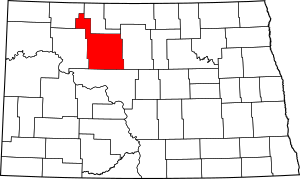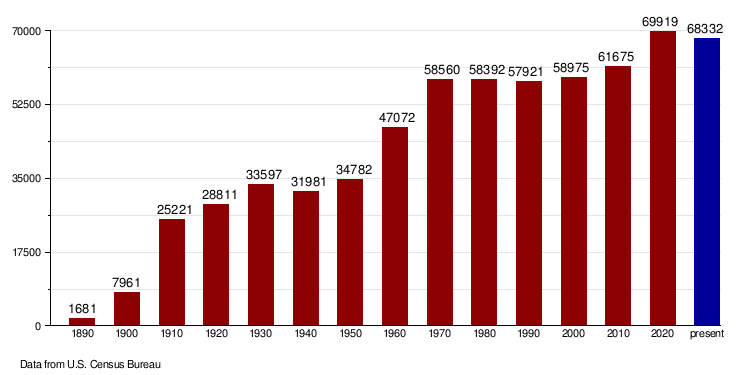Ward County, North Dakota facts for kids
Quick facts for kids
Ward County
|
|
|---|---|

Ward County Administration Building
|
|

Location within the U.S. state of North Dakota
|
|
 North Dakota's location within the U.S. |
|
| Country | |
| State | |
| Founded | April 14, 1885 (created) November 23, 1885 (organized) |
| Named for | Mark Ward |
| Seat | Minot |
| Largest city | Minot |
| Area | |
| • Total | 2,056 sq mi (5,330 km2) |
| • Land | 2,013 sq mi (5,210 km2) |
| • Water | 43 sq mi (110 km2) 2.1% |
| Population
(2020)
|
|
| • Total | 69,919 |
| • Estimate
(2023)
|
68,332 |
| • Density | 34.007/sq mi (13.130/km2) |
| Time zone | UTC−6 (Central) |
| • Summer (DST) | UTC−5 (CDT) |
| Congressional district | At-large |
Ward County is a county in the U.S. state of North Dakota. As of the 2020 census, the population was 69,919, making it the fourth most populous county in North Dakota. Its county seat is Minot. Ward County is part of the Minot, ND Micropolitan Statistical Area.
Contents
History
The Dakota Territory legislature created the county on April 14, 1885, with areas partitioned from Renville, Stevens, and Wynn counties (Stevens and Wynn counties are now extinct). The county government was not organized at that date; the organization was effected on November 23 of that year. The county was named for Mark Ward, chairman of the House of Representatives Committee on Counties during the session. Burlington was the county seat; this was changed to Minot in 1888.
The boundaries of Ward County were altered two times in 1887, and in 1892, 1909 and 1910. The present county boundaries have been in place since 1910.
Until 1908, Ward County included what is now Burke, Mountrail, and Renville counties; this landmass often being referred to as 'Imperial Ward' County and which was the largest county in the state at the time. In 1908, voters took up measures to partition the county. The results for that portion forming Mountrail County were accepted but the results for the portions that would become Burke and Renville counties were disputed in court, which resulted in favorable rulings in 1910. When the proposed county lines for Burke and Renville counties were drawn, neither group wanted to include Kenmare and risk that city's becoming the county seat, so Kenmare was left in Ward County at the end of a narrow strip of land, commonly referred to as the 'gooseneck'. One of the options reportedly considered around this time was to create a fifth county, Lake, with Kenmare as its seat.
Geography
The Des Lacs River flows southeasterly through the northeast part of the county before doubling to the northeast on its journey to Lake Winnipeg. The county terrain consists of low rolling hills, dotted with ponds and lakes in its southern part, and carved by drainage gullies. The area is largely devoted to agriculture. The terrain slopes to the east and north, with its highest point near the southwest corner, at 2,175 ft (663 m) ASL. The county has a total area of 2,056 square miles (5,330 km2), of which 2,013 square miles (5,210 km2) is land and 43 square miles (110 km2) (2.1%) is water. It is the fifth-largest county in North Dakota by land area.
Major highways
Transit
- Amtrak Empire Builder (Minot station)
- Minot City Transit
Adjacent counties
- Renville County – north
- McHenry County – east
- McLean County – south
- Mountrail County – west
- Burke County – northwest
Protected areas
- Des Lacs National Wildlife Refuge (part)
- Hiddenwood National Wildlife Refuge (part)
- National Wildfowl Production Areas
- Upper Souris National Wildlife Refuge (part)
Lakes
- Carpenter Lake
- Douglas Lake (part)
- Hiddenwood Lake (part)
- Makoti Lake
- Rice Lake
- Rush Lake
Demographics
| Historical population | |||
|---|---|---|---|
| Census | Pop. | %± | |
| 1890 | 1,681 | — | |
| 1900 | 7,961 | 373.6% | |
| 1910 | 25,221 | 216.8% | |
| 1920 | 28,811 | 14.2% | |
| 1930 | 33,597 | 16.6% | |
| 1940 | 31,981 | −4.8% | |
| 1950 | 34,782 | 8.8% | |
| 1960 | 47,072 | 35.3% | |
| 1970 | 58,560 | 24.4% | |
| 1980 | 58,392 | −0.3% | |
| 1990 | 57,921 | −0.8% | |
| 2000 | 58,975 | 1.8% | |
| 2010 | 61,675 | 4.6% | |
| 2020 | 69,919 | 13.4% | |
| 2023 (est.) | 68,332 | 10.8% | |
| US Decennial Census 1790–1960 1900–1990 1990-2000 2010-2020 |
|||
2020 census
As of the 2020 census, there were 69,919 people, 28,847 households, and 17,323 families in the county. The population density was 34.7 inhabitants per square mile (13.4/km2) There were 32,176 housing units.
2010 census
As of the 2010 census, there were 61,675 people, 25,029 households, and 15,597 families in the county. The population density was 30.6 people per square mile (11.8 people/km2). There were 26,744 housing units at an average density of 13.3 units per square mile (5.1/km2). The racial makeup of the county was 90.3% white, 2.6% American Indian, 2.5% black or African American, 0.9% Asian, 0.1% Pacific islander, 0.7% from other races, and 2.7% from two or more races. Those of Hispanic or Latino origin made up 3.0% of the population. In terms of ancestry, 44.4% were German, 30.8% were Norwegian, 11.6% were Irish, 5.7% were English, and 2.3% were American.
Of the 25,029 households, 30.6% had children under the age of 18 living with them, 49.9% were married couples living together, 8.4% had a female householder with no husband present, 37.7% were non-families, and 30.0% of all households were made up of individuals. The average household size was 2.36 and the average family size was 2.95. The median age was 32.7 years.
The median income for a household in the county was $48,793 and the median income for a family was $60,361. Males had a median income of $37,569 versus $28,415 for females. The per capita income for the county was $25,326. About 6.7% of families and 9.4% of the population were below the poverty line, including 13.0% of those under age 18 and 10.3% of those age 65 or over.
Population by decade

Communities
Cities
Census-designated places
Unincorporated communities
- Aurelia – (ghost town)
- Drady
- Gassman – founded when the Gassman Creek Coulee trestle was being built, now referred to as "Trestle Valley"
- Hartland – (ghost town)
- Hesnault
- Lonetree
- Rice Lake – community at Rice Lake near Minot
- South Prairie
- Wolseth
Historical areas
- Harrison – early community, now part of Minot
- Ralston – railroad siding
- Waldorf – early community, now part of Minot
Townships
- Afton
- Anna
- Baden
- Berthold
- Brillian
- Burlington
- Burt
- Cameron
- Carbondale
- Carpio
- Denmark
- Des Lacs
- Elmdale
- Eureka
- Evergreen
- Foxholm
- Freedom
- Gasman
- Greely
- Greenbush
- Harrison
- Hiddenwood
- Hilton
- Iota Flat
- Kenmare
- Kirkelie
- Linton
- Lund
- Mandan
- Margaret
- Maryland
- Mayland
- McKinley
- Nedrose
- New Prairie
- Newman
- Orlien
- Passport
- Ree
- Rice Lake
- Rolling Green
- Rushville
- Ryder
- St. Marys
- Sauk Prairie
- Sawyer
- Shealy
- Spencer
- Spring Lake
- Sundre
- Surrey
- Tatman
- Tolgen
- Torning
- Vang
- Waterford
- Willis
See also
 In Spanish: Condado de Ward (Dakota del Norte) para niños
In Spanish: Condado de Ward (Dakota del Norte) para niños

